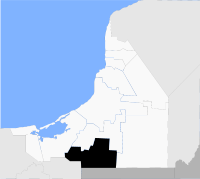Candelaria Municipality
Candelaria is one of the 11 municipalities that make up the Mexican state of Campeche. It is situated at the south of the state, and the municipal seat, and largest settlement, is the city of Candelaria. As of 2010, the population was 41,194.
Candelaria | |
|---|---|
 Coat of arms | |
 Location of Candelaria | |
 Candelaria Location of Candelaria  Candelaria Candelaria (Mexico) | |
| Coordinates: 18°0′N 90°45′W | |
| Country | |
| State | Campeche |
| Municipal seat | Candelaria |
| Government | |
| • Municipal president | (2006-09) |
| Area | |
| • Total | 5,518.5 km2 (2,130.72 sq mi) |
| Elevation | 49 m (161 ft) |
| Population (2015) | |
| • Total | 43,879 |
| • Density | 8.0/km2 (21/sq mi) |
| Time zone | UTC−6 (Central (US Central)) |
| • Summer (DST) | UTC−5 (Central) |
| Created | 19 June 1998 |
| Website | www.candelaria.gob.mx/ |
The name "Candelaria" is in reference to the Río Candelaria, a river which drains the region.
History and geography
The municipality of Candelaria borders to the north with the municipality of Escárcega; to the south with Guatemala and the state of Tabasco; to the east with the municipality of Calakmul, and to the west with the municipality of Carmen. It covers a total surface area of 5,518.55 km².
The region is a part of a large plain. The lowest altitude is 10 meters above sea level, and the highest is 100 meters above sea level. The plain is generally flat with moderate hills. A large river, the Candelaria River, runs through the municipality.
On 25 April 1984, the State Congress heard a request made by the residents of the region for it to be established as an autonomous municipality. The municipality of Candelaria was created by the Congress on 19 June 1998.
Hydrography
The Candelaria region is part of the Grijalva-Usumacinta hydrological system, which includes the Candelaria River. The Candelaria River begins in the Petén Department in Guatemala, (where it is called the San Pedro River), and empties into the Boca de Pargos, in the Carmen Lagoon. The river is 402 km long. Its primary tributaries are the San Pedro River and the Caribbean River, while its primary sub-tributaries include these streams: Las Golondrinas, Ojo de Agua, Pejelagarto, Arroyo Negro, and La Esperanza, the latter being the longest. The Candelaria River has several waterfalls. Some of these include the Waterfall of Death, Grande Waterfall, and Bull Waterfall.
Climate
This region varies between a warm humid climate and a rainy, warm, Humid subtropical climate, with monsoon rains occurring during the summer. The average annual temperature is 25 degrees Celsius. Annual precipitation in the Candelaria region is approximately 1700 mm, from the period of May to December, with much of that rainfall occurring in the months of September and October.
Demographics
According to the 2005 Population and Housing count, the municipality has a total of 49,850 inhabitants.
As of 2010, the city of Candelaria had a population of 9,812.[1] Other than the city of Candelaria, the municipality had 1,401 localities, the largest of which (with 2010 populations in parentheses) were: Benito Juárez Uno (1,281) and El Naranjo (1,065), classified as rural.
References
- Link to tables of population data from Census of 2005 Instituto Nacional de Estadística, Geografía e Informática (INEGI)
- Candelaria Enciclopedia de los Municipios de México, INAFED
External links
- Ayuntamiento de Candelaria Municipal website (in Spanish)
- Municipio de Candelaria from Campeche state government website (in Spanish)
